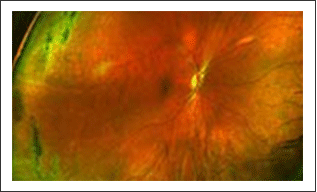For patients who have peripheral retinal changes associated with lattice degeneration, the lattice inevitably undergoes further deterioration. However, in most patients, this deterioration is not vision threatening. The deterioration that can be seen in the peripheral retina is generally not visible to the patient. However, your eye care providers will be able to notice and monitor these progressive changes. These changes may include the development of tractional changes in the areas of lattice, extension of the lattice i.e. increase in size, sclerosis of vessels, and areas of atrophic hole formations. In the majority of these situations, no further intervention is warranted and simple screening coupled with symptom management by patients who look for progressive symptoms such as flashing lights, a black curtain extending across their vision, or new onsets of floaters can trigger further investigations and possible management.
Conversely, lattice degeneration can lead to tears in the peripheral retina and retinal detachment, both of which can cause vision loss. Treatment of lattice degeneration involves inspecting its progression over the long term and using laser treatments to either prevent vision loss or fix it. Cryo therapy, while a less common method of treatment, is also used to treat patients with lattice degeneration.

A retina with lattice degeneration (above)
has darker pigmentation than a healthy one.

